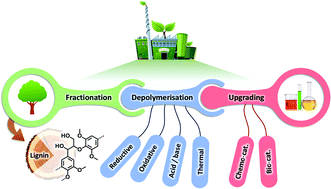当前位置:
X-MOL 学术
›
Chem. Soc. Rev.
›
论文详情
Our official English website, www.x-mol.net, welcomes your
feedback! (Note: you will need to create a separate account there.)
Chemicals from lignin: an interplay of lignocellulose fractionation, depolymerisation, and upgrading†
Chemical Society Reviews ( IF 40.4 ) Pub Date : 2018-01-10 00:00:00 , DOI: 10.1039/c7cs00566k W. Schutyser 1, 2, 3, 4, 5 , T. Renders 1, 2, 3, 4 , S. Van den Bosch 1, 2, 3, 4 , S.-F. Koelewijn 1, 2, 3, 4 , G. T. Beckham 5, 6, 7, 8 , B. F. Sels 1, 2, 3, 4
Chemical Society Reviews ( IF 40.4 ) Pub Date : 2018-01-10 00:00:00 , DOI: 10.1039/c7cs00566k W. Schutyser 1, 2, 3, 4, 5 , T. Renders 1, 2, 3, 4 , S. Van den Bosch 1, 2, 3, 4 , S.-F. Koelewijn 1, 2, 3, 4 , G. T. Beckham 5, 6, 7, 8 , B. F. Sels 1, 2, 3, 4
Affiliation

|
In pursuit of more sustainable and competitive biorefineries, the effective valorisation of lignin is key. An alluring opportunity is the exploitation of lignin as a resource for chemicals. Three technological biorefinery aspects will determine the realisation of a successful lignin-to-chemicals valorisation chain, namely (i) lignocellulose fractionation, (ii) lignin depolymerisation, and (iii) upgrading towards targeted chemicals. This review provides a summary and perspective of the extensive research that has been devoted to each of these three interconnected biorefinery aspects, ranging from industrially well-established techniques to the latest cutting edge innovations. To navigate the reader through the overwhelming collection of literature on each topic, distinct strategies/topics were delineated and summarised in comprehensive overview figures. Upon closer inspection, conceptual principles arise that rationalise the success of certain methodologies, and more importantly, can guide future research to further expand the portfolio of promising technologies. When targeting chemicals, a key objective during the fractionation and depolymerisation stage is to minimise lignin condensation (i.e. formation of resistive carbon–carbon linkages). During fractionation, this can be achieved by either (i) preserving the (native) lignin structure or (ii) by tolerating depolymerisation of the lignin polymer but preventing condensation through chemical quenching or physical removal of reactive intermediates. The latter strategy is also commonly applied in the lignin depolymerisation stage, while an alternative approach is to augment the relative rate of depolymerisation vs. condensation by enhancing the reactivity of the lignin structure towards depolymerisation. Finally, because depolymerised lignins often consist of a complex mixture of various compounds, upgrading of the raw product mixture through convergent transformations embodies a promising approach to decrease the complexity. This particular upgrading approach is termed funneling, and includes both chemocatalytic and biological strategies.
中文翻译:

木质素中的化学物质:木质纤维素分馏,解聚和提质的相互作用†
为了追求更具可持续性和竞争力的生物精炼厂,木质素的有效增值至关重要。诱人的机会是利用木质素作为化学品的资源。生物炼制技术的三个方面将决定成功的木质素到化学物质的价值链的实现,即(i)木质纤维素分级分离,(ii)木质素解聚,以及(iii)升级为目标化学品。这篇综述提供了针对这三个相互关联的生物精炼方面的广泛研究的摘要和观点,范围从工业成熟的技术到最新的前沿创新。为了使读者浏览有关每个主题的大量文献,概述了不同的策略/主题,并在综合概述图中进行了总结。仔细检查后,就会出现一些概念性原理,这些原理使某些方法论的成功合理化,更重要的是,它可以指导未来的研究以进一步扩展有前途的技术产品组合。靶向化学品时,分馏和解聚阶段的关键目标是使木质素缩合最小化(即形成电阻碳-碳键)。在分馏期间,这可以通过(i)保留(天然)木质素结构或(ii)通过容许木质素聚合物的解聚但通过化学淬灭或物理除去反应性中间体来防止缩合来实现。后者策略也通常用于木质素解聚阶段,而另一种方法是增加解聚相对于解聚的相对速率。通过增强木质素结构对解聚的反应性来缩合。最后,由于解聚的木质素通常由各种化合物的复杂混合物组成,因此通过会聚转化对粗产物混合物进行提纯体现了一种降低复杂性的有前途的方法。这种特殊的升级方法称为漏斗,包括化学催化和生物学策略。
更新日期:2018-01-10
中文翻译:

木质素中的化学物质:木质纤维素分馏,解聚和提质的相互作用†
为了追求更具可持续性和竞争力的生物精炼厂,木质素的有效增值至关重要。诱人的机会是利用木质素作为化学品的资源。生物炼制技术的三个方面将决定成功的木质素到化学物质的价值链的实现,即(i)木质纤维素分级分离,(ii)木质素解聚,以及(iii)升级为目标化学品。这篇综述提供了针对这三个相互关联的生物精炼方面的广泛研究的摘要和观点,范围从工业成熟的技术到最新的前沿创新。为了使读者浏览有关每个主题的大量文献,概述了不同的策略/主题,并在综合概述图中进行了总结。仔细检查后,就会出现一些概念性原理,这些原理使某些方法论的成功合理化,更重要的是,它可以指导未来的研究以进一步扩展有前途的技术产品组合。靶向化学品时,分馏和解聚阶段的关键目标是使木质素缩合最小化(即形成电阻碳-碳键)。在分馏期间,这可以通过(i)保留(天然)木质素结构或(ii)通过容许木质素聚合物的解聚但通过化学淬灭或物理除去反应性中间体来防止缩合来实现。后者策略也通常用于木质素解聚阶段,而另一种方法是增加解聚相对于解聚的相对速率。通过增强木质素结构对解聚的反应性来缩合。最后,由于解聚的木质素通常由各种化合物的复杂混合物组成,因此通过会聚转化对粗产物混合物进行提纯体现了一种降低复杂性的有前途的方法。这种特殊的升级方法称为漏斗,包括化学催化和生物学策略。











































 京公网安备 11010802027423号
京公网安备 11010802027423号